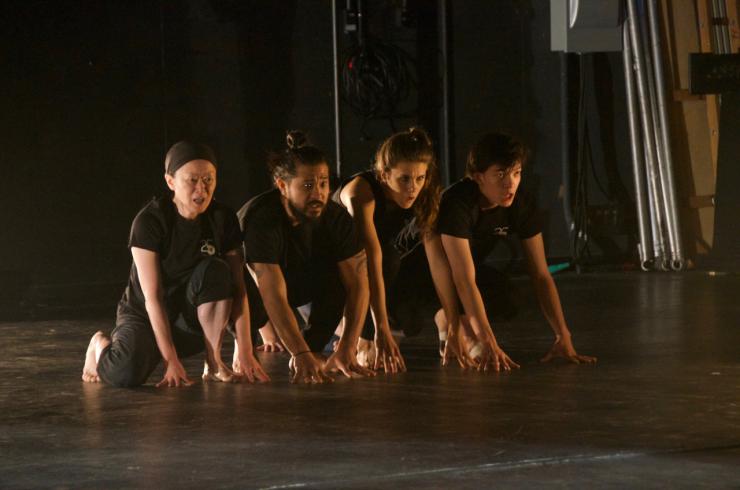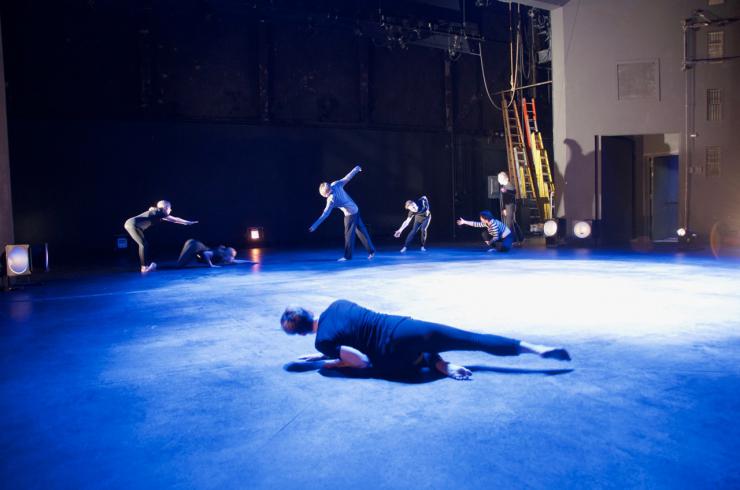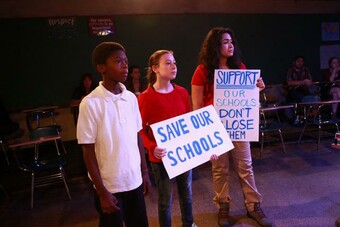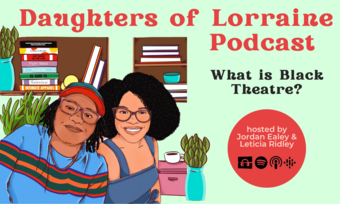Talking about Protest with the Language of Actor Training
Since the 2016 presidential election, the performativity of public protest has increasingly drawn national attention, from kneeling during the national anthem to the historic Women’s March to the National School Walkout. Most of us have protest stories, and often the most memorable are the ones in which “performance” is a key element. Take, for instance, the student activists who laid on the floor outside of Paul Ryan’s office as a call for stricter gun control. And, conversely, consider Kaitlin Bennett, a female student who recently posed on the Kent State campus with her AR-10 in order to advocate for Campus Carry.
We love to perform, not only because performance gets page likes, but also because performativity often delivers the message more clearly than if we had simply written to our senators. From my own position as an actor and as a literature and theatre professor at Greenville University, a small liberal arts college in Illinois, I recognize this renewed fervor for public protest in both my students and my fellow theatre artists. I recognize it in myself, too.
I’ve been starting to think about how my identity as an actor can help me engage with protest on a level beyond just coming up with compelling concepts for public demonstrations. The question I keep coming back to is how can we theatre artists play the role of mediator, not just provocateur, in potentially contentious protests. Recently, I’ve seen this play out in multiple ways both at the school I work at and in the community I live in.
National Anthem Protests
In the midst of the 2016 election, my university experienced incredible institutional turmoil over our students kneeling during the national anthem at athletic events in protest of racial injustice. This was a public act popularized by former 49ers quarterback (and now award-winning activist) Colin Kaepernick, the reverberations of which recently resulted in the NFL mandating that players stand during the anthem.
When the news circulated in our small Midwestern town that some of our student athletes joined this act of resistance—taking part in micro-performances at our school’s own football games—our institution began to experience profound backlash from community members, veteran groups, parents, and alumni.
Around campus, we heard whispers of donors pulling funding and parents barring their kids from enrolling, something other institutions inevitably deal with when a campus wades into a controversial issue. One morning in late fall, however, we awoke to find our campus peppered with signs that read, “Stand Up or Get Out.” College employees quickly removed the signs, but the threatening language still stung.
A few weeks later, our homecoming game unexpectedly featured a large number of veterans—many of whom arrived on motorcycles—who marched onto the field during the national anthem, with a small group serving as color guard. Our administrators, rightfully focused on the security of our students, hurriedly escorted the athletes off the field.
In some ways, it’s unsurprising that these protests materialized at my institution, since we are only an hour’s drive from Ferguson, Missouri. Our geographical location alone places us in the immediate vicinity of the ongoing conversation about race in America. And now, with the reality of a Trump presidency, our students feel the weight of protest more than ever.
National anthem protests are a fantastic example of performance as activism, since they require an explicitly performative moment in order to send a message about injustice.
Performance as Activism
National anthem protests are a fantastic example of performance as activism, since they require an explicitly performative moment in order to send a message about injustice. Discussions about performance as activism are not exactly new in the field of performance studies, but in a community that has almost no history of public protest, like my college’s town, they are. It’s fascinating to be in a context where community members are responding intensely to performative moments, yet they cannot quite articulate why they are responding the way they are. In the case of my institution, the response was one of frustration and hostility, and it seemed like the conversation between protestors and the resistance never really found a sense of reconciliation.
This is the kind of conversation that we as theatremakers hope we can enter into: What makes something a performance, how are spectators responding to that performance, and can theatre artists articulate why and how that response was generated? For myself, I’ve been trying to think actively about what I can offer to these types of conversations as an actor. I’m growing more and more convinced that the way I was taught to speak about my body in space, and in relationship to other bodies, is potentially a powerful tool for dialoging with others about protest.
My own training as an actor is grounded in Viewpoints, the movement vocabulary created by choreographer Mary Overlie and adapted for actors by SITI Company’s Anne Bogart and Tony-nominated director Tina Landau. Each “Viewpoint” is one of the materials that make up a performance, such as space, shape, time, or movement. For instance, if a performance were to be deconstructed into to its component parts, then each individual Viewpoint would suddenly come into focus.

Within actor training and ensemble development, Viewpoints is primarily applied prescriptively: the practice of introducing it to an ensemble can serve the rehearsal process and contribute to the development of captivating compositions. When thinking about public protest, I was surprised to find that Viewpoints could function retrospectively and descriptively, not just prescriptively.
Mary Overlie originally articulated the Six Viewpoints in the 1970s as a way to help create and analyze dance. Bogart and Landau adapted this, expanding them to apply directly to actor training and ensemble work. The expanded Viewpoints are organized according to time (including tempo, duration, kinesthetic response, and repetition) and to space (including shape, gesture, architecture, spatial relationship, and topography).
Thinking about the national anthem protests through the lens of performance studies has made one of Viewpoints’ greatest strengths—its terminology—come to the forefront of my mind. In The Viewpoints Book, Bogart and Landau explain:
Viewpoints appears everywhere in life: in the way people move, the way animals clock, the way cars pass on the highway. Frequently, when someone first learns the names of the individual Viewpoints, they become obsessed with spotting them at work everywhere: “Did you see how those people over there responded Kinesthetically to each other?!” Of course, this is the way life always is and has been; but naming the Viewpoints allows us to dissect reality into something identifiable and perhaps repeatable onstage.
An obvious parallel for the national anthem protests is the Viewpoint of shape, specifically gesture. Kneeling is what Bogart and Landau call an “expressive gesture,” one that communicates an inner state of being, and, like all gesture, it is a shape with a clear beginning, middle, and end. So, if we have about one-fourth of the students kneeling, we’re faced with a line of students—some kneeling, some not—directly confronting their spectators for a duration (a Viewpoint of time) of roughly two minutes. The students who kneel, then, have taken on an expressive gesture that, if taken out of context, would traditionally communicate humility, submission, or even worship.

The thing that really defined our homecoming game, however, was the Viewpoint of kinesthetic response. Right before the pre-game rituals, you could hear a large troupe of motorcycle riders getting closer and closer to the field. Their engines were loud, occasionally popping, and the sounds they produced noticeably disrupted the late morning, pre-game peace. People became tense, quiet, and the coaches immediately realized the necessity to keep the students at a healthy distance.
Consider, too, how the architecture of our space—the football field, which is detached, isolated, and has limited access—might interact with the sound of a motorcycle troupe entering. When the riders dismounted and made it clear that they planned to stand on the field, the response of our athletic staff was to put as much space between them and the students as possible, and the students were instructed to leave the field.
When protestors have a language to describe how their bodies are interacting with and affecting the space around them, they can more productively dialogue with resistance.
Theatre Artists as Mediators
It’s fine to discuss Viewpoints theoretically with respect to these national anthem protests, but what is the practical application?
When protestors have a language to describe how their bodies are interacting with and affecting the space around them, they can more productively dialogue with resistance. Looking back on the drama surrounding national anthem protests at my university, I’m struck by how much a neutral vocabulary would have helped the hard conversations that followed.
A prime example of this would be around the appearance of the motorcyclists. Protestors and spectators were quick to call it an act of intimidation, and the bikers were likewise quick to argue that this was simply their preferred means of transportation on a Saturday morning. But when we discuss the act in terms of kinesthetic response, architecture, or spatial relationship, suddenly fruitful dialogue becomes more feasible because the things we describe are tangible, evident, and not limited to one particular context.
This is an instance where a vocabulary created by performing artists could have real impact on the general population, especially when the United States’ current political climate has inspired such a renewed passion for activism and protest. Imagine how protest organizers might use Viewpoints to plan best- and worst-case scenarios for a march. If there are thousands of bodies moving through space together, wouldn’t it be helpful to have a shared vocabulary for all of the different elements that could affect not only the safety of those bodies, but also the message those bodies send? When organizers and protestors alike are able to describe the raw materials of human beings at work in space, they can then more carefully explain the stories and emotions that arise from those materials.
Often theatre artists play the role of provocateur, but I really believe this is an example of how we can also be mediators. Training paradigms like Viewpoints help us all get along just a little bit better, since they ask us to pay heightened attention to the basic materials at work in ourselves, in others, and in the spaces between us.














Comments
The article is just the start of the conversation—we want to know what you think about this subject, too! HowlRound is a space for knowledge-sharing, and we welcome spirited, thoughtful, and on-topic dialogue. Find our full comments policy here
Love this - I think you talked about this on our ATHE panel last year? I feel re-inpsired to explore this concept further. "The Performer as Mediator" aspect is spot on! Thank you for sharing.